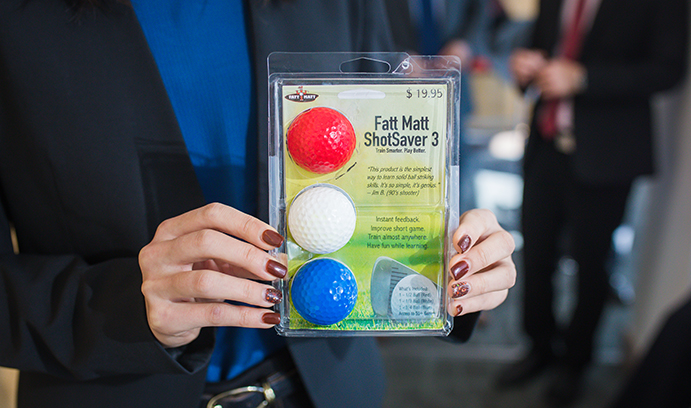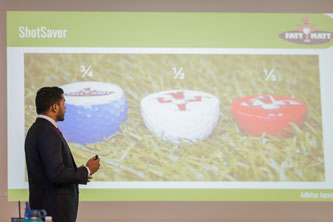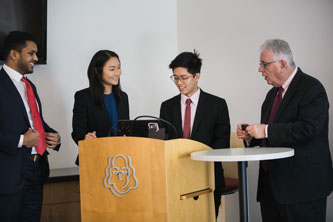Chipping Away: IBE Team Helps Bring Golf Training Device to Market

The Shot Saver is a set of specialized golf balls geared toward golfers struggling with their chipping game. The product forces golfers who fear hitting down on a golf ball to adjust accordingly for each shot.
As the harsh cold of winter kept golfers training indoors in early 2018, a team of Integrated Business and Engineering students were honing their own skills both on and off the green.
The team consists of Tech Tanasarnsopaporn ’19, Adhitya Jayasinghe ’19, Hanna Mo ’19, Ethan Frohman ’19, Justin Hassenfeld ’19, Kevin Tsao ’19 and Jackson Monnin ’19. After browsing through different projects during an IBE project roundtable, the team decided to partner with local golf pro Mark Csencsits to help bring a new training device—the Shot Saver—to market.
“[Mark] does lessons all the time, but in his free time he has come up with a couple of products that he’s labeled his Fatt Matt brand,” Monnin said. “We are helping him create a business model for what we think is his most viable product.” The team pitched its plans to prospective investors at Ben Franklin Tech Ventures in December.
The IBE capstone project , as well as the program itself, aims to prepare students for working in a corporate environment. Offered jointly by the P.C. Rossin College of Engineering and Applied Science and the College of Business and Economics, IBE integrates courses in business and engineering with additional requirements in mathematics, science, English, humanities and foreign language.
A highlight of IBE is its two-semester, six-credit capstone design course run by professor Pat Costa. Teams of students work with faculty mentors on the marketing, financial and economic planning, and technical and economic feasibility of new product concepts.
The Shot Saver is a set of specialized golf balls meant to be a training device geared toward golfers who struggle chipping onto the green. Each Shot Saver package contains three golf balls cut halfway, one-third of the way, and one-quarter of the way from the top, respectively. Golfers are often afraid to hit down on the ball while chipping, Monnin said, so forcing them to adjust for each new ball will literally “save shots” on the green.
Mo said that after establishing the Shot Saver as its product focus, the team began work on the logistics of bringing the balls to market.
“The biggest issue we had to deal with was how to manufacture it, package it, distribute it,” Mo said. “We had to contact different manufacturers inside and outside the U.S., and use different methods to cut the balls. There's so many different methods, so hopefully we can bring it to market soon.”
Monnin said the team’s other difficulties have largely come from the decision-making process. He said being resourceful when deciding which manufacturer to work with, or finding effective local packagers, was both the most rewarding and most challenging part of the project.
Frohman said the team’s other focus has been helping Csencsits figure out how to raise funds to further develop the Shot Saver. The team learned how to create effective Kickstarter campaigns, and are in the process of finishing a Kickstarter video and page for the product.
While the students do not have any plans to work with Csencsits after the fall 2018 semester, Frohman said the team has definitely furthered themselves in terms of professional development and consulting with a client.
“A good number of us are going to work in consulting,” Frohman said, “and this product basically has been one long consulting assignment. What Professor Costa does best is treat us like we’re in the workplace and holding us to that higher standard. It’s preparing us for those jobs that we’ll have moving forward.”
“Working with Mark has been really great,” Monnin said. “He’s brought a lot of compassion and energy to the project on a weekly basis, he has a lot of great ideas, and he’s been a great resource to bounce some of our own ideas off of. It's been a great opportunity for us as students to understand the real world consequences of our decisions. This is his livelihood, so to speak, and we’re trying to help him achieve his goals. It’s been great to get a real learning experience.”
Story by Sam Topp '19
Photos by Christa Neu
Posted on:





